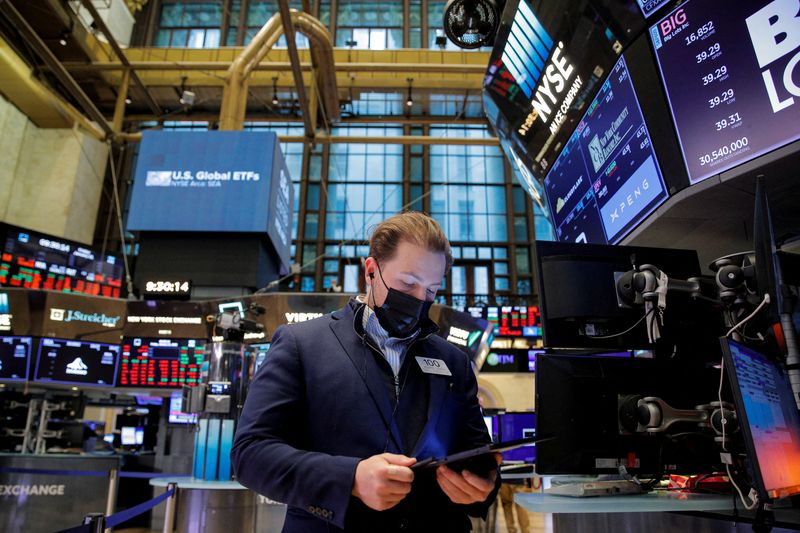By Lewis Krauskopf, Shreyashi Sanyal and Bansari Mayur Kamdar
(Reuters) - Wall Street's main indexes ended sharply lower on Friday as Netflix (NASDAQ:NFLX) shares plunged after a weak earnings report, capping a brutal week for stocks that saw the S&P 500 and Nasdaq log their biggest weekly percentage drops since the onset of the pandemic in March 2020.
The benchmark S&P 500 posted its third straight week of declines, ending 8.3% down from its early January record high.
Losses also deepened for the Nasdaq after the tech-heavy index earlier in the week confirmed it was in a correction, closing down over 10% from its November peak. The Nasdaq has now fallen 14.3% from its November peak and on Friday closed at its lowest level since June.
Netflix shares tumbled 21.8%, weighing on the S&P 500 and the Nasdaq, after the streaming giant forecast weak subscriber growth. Shares of competitor Walt Disney (NYSE:DIS) fell 6.9%, dragging on the Dow, while Roku (NASDAQ:ROKU) also slid 9.1%.
"It has really been a continuation of a tech rout,” said Paul Nolte, portfolio manager at Kingsview Investment Management. "It’s really a combination of a rotation out of technology as well as very poor numbers from Netflix that I think is the catalyst for today."
The Dow Jones Industrial Average fell 450.02 points, or 1.3%, to 34,265.37, the S&P 500 lost 84.79 points, or 1.89%, to 4,397.94 and the Nasdaq Composite dropped 385.10 points, or 2.72%, to 13,768.92.
For the week, the S&P 500 fell 5.7%, the Dow dropped 4.6% and the Nasdaq declined 7.6%.
The Dow fell for a sixth straight session, its longest streak of daily declines since February 2020.
The S&P 500 closed below its 200-day moving average, a key technical level, for the first time since June 2020.
"When markets get like they've gotten this week, the emotion is what takes over," said Jim Paulsen, chief investment strategist at The Leuthold Group. "Until it finds support, no one's going care about anything fundamental."
Stocks are off to a rough start in 2022, as a fast rise in Treasury yields amid concerns the Federal Reserve will become aggressive in controlling inflation has particularly hit tech and growth shares.
Investors are keenly focused on next week's Fed meeting for more clarity on the central bank's plans to tighten monetary policy in the coming months, after data last week showed U.S. consumer prices in December had the largest annual rise in nearly four decades.
“Between the Fed meeting and earnings, there is a lot that the market could be worried about next week,” said Anu Gaggar, global investment strategist at Commonwealth Financial Network.
Apple (NASDAQ:AAPL), Tesla (NASDAQ:TSLA) and Microsoft (NASDAQ:MSFT) are among the large companies due to report next week in a busy week of earnings results.
Declining issues outnumbered advancing ones on the NYSE by a 4.26-to-1 ratio; on Nasdaq, a 4.34-to-1 ratio favored decliners.

The S&P 500 posted five new 52-week highs and 24 new lows; the Nasdaq Composite recorded 13 new highs and 1,029 new lows.
About 14.6 billion shares changed hands in U.S. exchanges, compared with the 10.4 billion daily average over the last 20 sessions.
